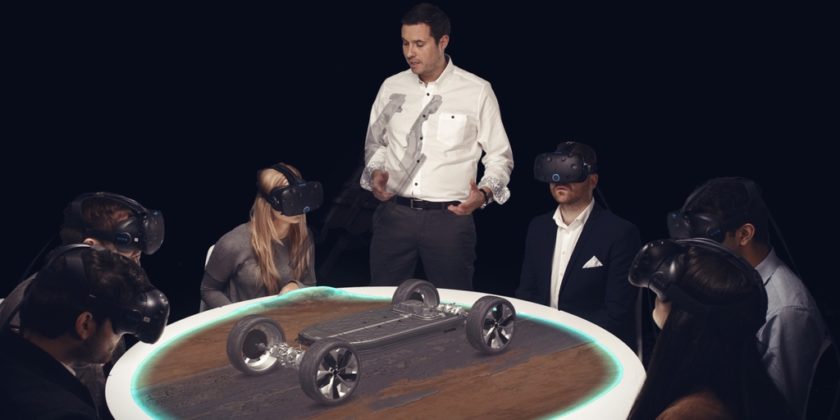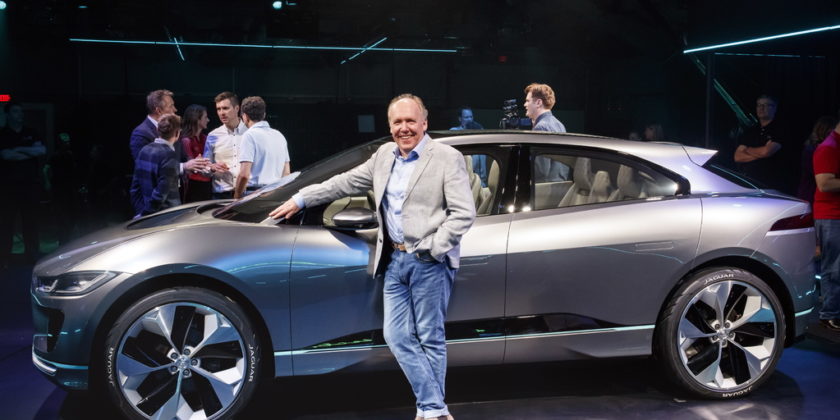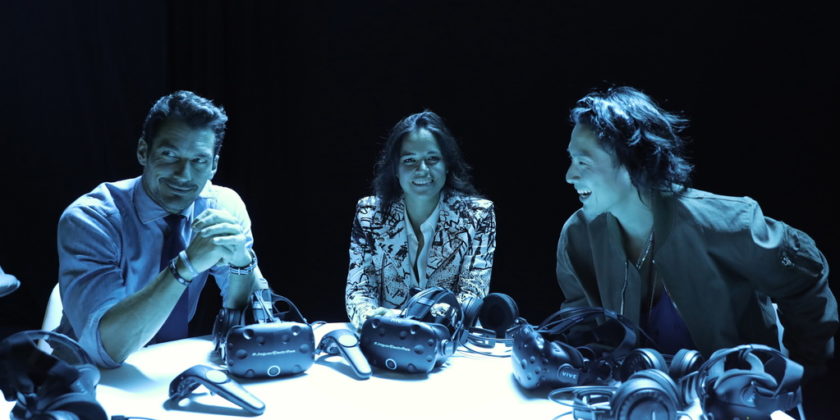Jaguar I-PACE concept launch: VR on the world stage
“Right from the outset we thought about this project differently, we’ve done things differently at every stage of the process and the end result is something that is out of this world.”
— Jaguar I-PACE
The ground-breaking project to launch the first Jaguar electric concept vehicle, the I-PACE was a game-changer for the brand, attracting global media attention and achieving several world firsts. Showcasing the potential of virtual reality on the international stage, the world’s first live cross-continent VR product launch reveal allowed the audience to explore the I-PACE concept in a 3D social space, using technology such as the HTC VIVE™ and the Dell Precision Workstation.
Sixty-six guests – 54 in LA, 12 in London – including journalists and celebrities like James Corden, Michelle Rodriguez and David Gandy – simultaneously experienced the car, both inside and outside, under the virtual guidance of its designer Ian Callum who was live-streamed onto the VR platform. With a 360° background view of Venice Beach, morphing into a virtual desert, the social VR capability allowed the audience to interact across continents, a world-first for an externally facing consumer launch.
The project was a collaboration between Jaguar and London-based global creative agency Imagination, working with REWIND, a UK immersive production studio, supported by HTC VIVE™ and Dell.
Why VR?
“We had looked at VR previously; however, in the past we didn’t think the technology was strong enough,” says Imagination’s Head of Automotive, Ross Wheeler. “But when the time came to tell the story to journalists around the world, it was a no-brainer, it had to be VR. We were telling a tech story and virtual reality was high on the news agenda, so we knew that anyone sharing this type of news could receive exponentially higher interest using virtual reality. VR quickly became the perfect channel and technology for us to use.”
“Our only real challenge was time – just four months from conception to launch”
— Ross Wheeler, Imagination Head of Automotive
Choosing the technology
High quality was key for the project, so a very high level of technology was required. “In total, we needed 114 PCs, one to run each seat at the presentation table, as well as behind-the-scenes redundancy,” reveals Imagination’s Russell Hall The project required more top of the range consumer graphics cards than were then available in the market to buy. Sixty-six HTC VIVE™ headsets were needed, the largest number ever used for a consumer product launch.
The HTC VIVE Room scale VR turned the audience space into an interactive 3D zone using 22 sensors to track the users’ movements, with motion-tracked handheld controllers to manipulate objects, interact and communicate. A server, similar to that used for Massive Online Multiplayer games (MMO) tracked each headset and relayed the coordinates to the other computers in the network across both continents. A live link was achieved by creating a virtual private cloud, running a global network to connect London and LA as if they were on the same network.
The team also worked with Unity’s real-time rendering engine, chosen for high level capabilities. As REWIND’s Matt Vernon-Clinch explains, “We pushed the engine to the limit of what it could do and what things could look like in VR, pushing the realism of anything we had ever done before.”
The merging of high-spec technologies and the powerful results achieved – news of the launch reached 263m people around the world and the launch video quickly accumulated 1m YouTube views – showed what was possible using VR technology.

Overcoming the challenges
Achieving the quality required by the client and world media was key, rendering the high spec car design in sufficiently high definition to provide the wow factor, as well as allowing the audience to get as close as possible to experience the design details. The Unity real-time engine provided the answer, allowing the data to be streamlined while still retaining high visual quality. It was necessary to remove 97% of data from the high resolution CAD model of the car supplied by Jaguar so that the Unity games engine could process at 90 frames per second.
The need to create something that was intuitive and easy to use was also of paramount importance, stress Matt Vernon-Clinch, particularly in a shared VR experience where all participants are interacting without sharing a physical space. Again, the game-based technology elements allowed the creators to draw on gaming culture, using the multi-player facility to connect participants on both sides of the world. As a warm up exercise, the audience played Scalextric to create group awareness and familiarise themselves with the controls.
Instead of the ‘push to speak’ button that gamers use to communicate across a virtual space, spotlights and audience avatars facilitated the group’s interaction. There was an issue around audio time delay when two people spoke to each other across 5000 miles of cable between the continents, which was resolved by using Imagination’s immersive theatre background to stage manage the show and bring the elements together. Open-back headphones meant that each participant could hear environmental sounds, the main experience backing track as well as key presenter announcement, while still being immersed in the total experience.

Launch day: feedback
The feedback at the launch and in the media exceeded the entire team’s targets and expectations. Actor and TV presenter James Corden claimed it had blown his mind. VR Focus said, “Jaguar just showed us the future of car launches” and the International Business Times claimed, “Jaguar’s use of VR means product launches will never be the same again”.
Lessons learned: changing consumer experiences
Ross Wheeler, Head of Automotive at Imagination, believes with this launch that Jaguar has permanently redefined the format of product launches, setting the benchmark for any consumer brand experience, for any sector, for years to come.
Research shows that the brain responds in a different way to virtual reality than to real-world environments but by affecting positively the way the brain retrieves information, a virtual experience can feel entirely real. “I convinced myself I had sat in the car, my brain was convinced I had done that because I can describe every single feature inside,” explains Ross. “The future of VR is a very powerful one.”
Lessons learned: changing working processes
Imagination is currently building a content platform that will allow other brands to broadcast interactive content in a similar way, taking insights gained from this project and packaging it up into a toolkit, which will also allow consumers to enjoy the experience at home. They also plan to use this platform as a communication tool, connecting its offices all around the world and enabling teams to work closer together.
VR in the automotive industry: what does the future look like?
“Jaguar, by embracing cutting-edge technology in this way, has created an experience rich and rewarding for its consumers. It has undoubtedly redefined the future of how automotive brands introduce their new vehicles to customers.”
— Ross Wheeler, Imagination
The challenge has been finding people with the right skills, people who “know what they are talking about”, as Ross Wheeler puts it.
“We’re now in the same place we were in with social media seven or eight years ago. Today everybody is a VR producer, but what that normally means is that they’ve worked with 360° video. The web has gone through years of hell to get to a place where user experience is core. We need to do the same for the VR journey. Currently there is no established approach to UX design in VR, it will be exciting to watch this area grow as it has done on the web. We need to make sure people understand the breath of skills needed in the industry, and both government and the industry itself need to invest in building those skills.”
As well as the skills landscape, the consumer automotive sector is set to undergo a huge change. As Ross puts it, in a world where VR starts to play a leading role, do we need to see cars in dealerships anymore?
“I buy now from Amazon, I do my grocery shopping online at Tesco, I don’t need to be in the shops. In the same way, I can fully experience a car with a headset on, speaking to a real-life virtual person who has been streamed in. I can sit in the car and I can see it on my driveway in front of my house. VR is a very powerful retail tool.”
What will empower VR for the future, Ross believes, is the access to technology for the masses. “Once the technology and hardware enters the mainstream, it’s going to change everything,” he confirms. “Then companies will start to spend serious money on this form of marketing and product presentation.”
Words by Bernadette Fallon
